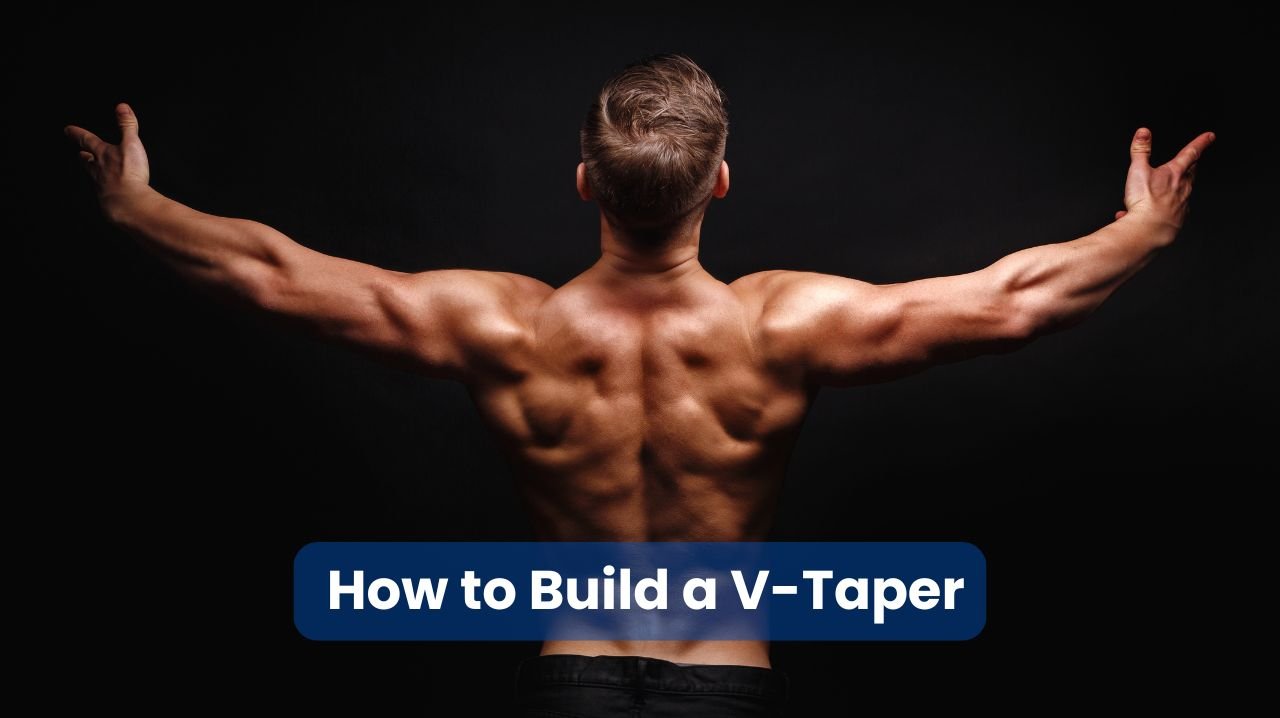How to Build a V-Taper: Tips for Sculpting Your Back and Shoulders
For fitness enthusiasts and bodybuilders alike, achieving the coveted V-taper physique is often a top priority. A well-developed V-taper not only enhances overall aesthetics but also signifies strength and athleticism.
This article will delve into the intricacies of building a V-taper, providing valuable insights and practical tips for sculpting your back and shoulders.
👉 Pack On Muscle Mass and Get Bigger and Stronger
👉 Burn Fat and Get Seriously Ripped
👉 Get Explosive Strength and Maximum Stamina
👉 Become A Gym Beast With Legal SARMs Alternatives
Understanding the V-Taper
The V-taper refers to the visual effect created by broad shoulders, a wide back, and a narrow waist. This silhouette resembles an inverted triangle or the letter “V,” hence the name. A well-defined V-taper is not just about looks; it’s a testament to a balanced and well-rounded physique.
Key Components of a V-Taper
To achieve an impressive V-taper, focus on developing these key areas:
- Shoulders (deltoids)
- Upper back (latissimus dorsi or “lats”)
- Lower back
- Chest
- Core (for a trim waistline)
The Science Behind Building a V-Taper
Before diving into specific exercises and techniques, it’s essential to understand the physiological aspects of developing a V-taper. Muscle hypertrophy, or muscle growth, is the primary goal when working towards this physique.
Muscle Hypertrophy and Progressive Overload
Muscle growth occurs when muscle fibers are subjected to stress and subsequently repair and adapt. This process is known as hypertrophy. To continually promote muscle growth, one must employ the principle of progressive overload – gradually increasing the weight, frequency, or number of repetitions in strength training routines.
The Role of Nutrition
Building a V-taper isn’t just about exercise; proper nutrition plays a crucial role. A balanced diet rich in protein, complex carbohydrates, and healthy fats provides the necessary fuel for muscle growth and recovery.
Essential Exercises for Building a V-Taper
Now, let’s explore some key exercises that target the muscles responsible for creating the V-taper effect.
Shoulder Exercises
Developing broad, rounded shoulders is crucial for achieving a V-taper. Focus on exercises that target all three heads of the deltoid muscle.
Overhead Press
The overhead press, also known as the military press, is a compound movement that primarily targets the anterior (front) deltoids.
- Stand with feet shoulder-width apart
- Hold a barbell at shoulder level with an overhand grip
- Press the barbell overhead until arms are fully extended
- Lower the bar back to shoulder level with control
Lateral Raises
Lateral raises isolate the lateral (side) deltoids, helping to increase shoulder width.
- Stand with dumbbells at your sides
- Raise the dumbbells out to the sides until they reach shoulder level
- Lower the weights back down with control
Reverse Flyes
This exercise targets the posterior (rear) deltoids, crucial for overall shoulder development and posture.
- Bend at the hips with a flat back, holding dumbbells
- Raise the dumbbells out to the sides, focusing on squeezing the rear deltoids
- Lower the weights back down with control
Back Exercises
A wide, well-developed back is essential for creating the V-taper effect. The following exercises target the latissimus dorsi, the largest muscle in the upper body.
Pull-Ups
Pull-ups are one of the most effective exercises for building a wide back.
- Hang from a pull-up bar with hands slightly wider than shoulder-width
- Pull yourself up until your chin clears the bar
- Lower yourself back down with control
Lat Pull-Downs
For those who struggle with pull-ups, lat pull-downs are an excellent alternative.
- Sit at a lat pull-down machine with a wide grip on the bar
- Pull the bar down to your upper chest, focusing on using your back muscles
- Slowly return the bar to the starting position
Barbell Rows
Rows help develop thickness in the back, contributing to the overall V-taper appearance.
- Bend at the hips with a flat back, holding a barbell
- Pull the barbell towards your lower chest
- Lower the bar back down with control
Core Exercises
While building a wide back and shoulders is crucial, maintaining a trim waistline is equally important for accentuating the V-taper.
Planks
Planks are excellent for developing core stability and endurance.
- Start in a push-up position with forearms on the ground
- Keep your body in a straight line from head to heels
- Hold this position for 30-60 seconds
Russian Twists
This exercise targets the obliques, helping to sculpt the sides of the waist.
- Sit on the floor with knees bent and feet off the ground
- Lean back slightly, keeping your back straight
- Twist your torso from side to side, touching the ground on each side
Creating an Effective Workout Routine
To build a V-taper effectively, it’s crucial to design a well-structured workout routine that targets all the necessary muscle groups. Here’s a sample weekly routine:
| Day | Muscle Group | Exercises |
|---|---|---|
| Monday | Back and Biceps | Pull-ups, Barbell Rows, Lat Pull-downs, Bicep Curls |
| Tuesday | Chest and Triceps | Bench Press, Incline Dumbbell Press, Tricep Pushdowns |
| Wednesday | Rest or Light Cardio | – |
| Thursday | Shoulders and Abs | Overhead Press, Lateral Raises, Reverse Flyes, Planks, Russian Twists |
| Friday | Legs | Squats, Deadlifts, Leg Press, Calf Raises |
| Saturday | Rest or Light Cardio | – |
| Sunday | Rest | – |
Nutrition Tips for Building a V-Taper
Proper nutrition is crucial for building muscle and maintaining a low body fat percentage, both of which are essential for achieving a V-taper physique. Here are some key nutritional tips:
Protein Intake
Consuming adequate protein is vital for muscle growth and recovery. Aim for 1.6-2.2 grams of protein per kilogram of body weight daily. Good protein sources include:
- Lean meats (chicken, turkey, lean beef)
- Fish (salmon, tuna, tilapia)
- Eggs
- Low-fat dairy products
- Plant-based options (lentils, quinoa, tofu)
Carbohydrates for Energy
Carbohydrates provide the energy needed for intense workouts. Focus on complex carbohydrates such as:
- Whole grains (brown rice, oats, quinoa)
- Sweet potatoes
- Fruits
- Vegetables
Healthy Fats
Include healthy fats in your diet to support hormone production and overall health:
- Avocados
- Nuts and seeds
- Olive oil
- Fatty fish
Caloric Intake
To build muscle, you need to be in a slight caloric surplus. However, to maintain a trim waistline, this surplus should be moderate. Aim for 300-500 calories above your maintenance level.
Common Mistakes to Avoid
When working towards a V-taper physique, be aware of these common pitfalls:
- Neglecting rear deltoid development
- Overemphasizing isolation exercises at the expense of compound movements
- Ignoring proper form in favor of lifting heavier weights
- Failing to progressively overload
- Neglecting rest and recovery
- Not paying attention to nutrition
Advanced Techniques for Enhancing Your V-Taper
Once you’ve mastered the basics, consider incorporating these advanced techniques to further sculpt your V-taper:
Drop Sets
Perform an exercise to near failure, then immediately reduce the weight and continue for more repetitions. This technique can help induce muscle hypertrophy.
Supersets
Pair two exercises targeting the same muscle group and perform them back-to-back with minimal rest. This increases time under tension and can lead to greater muscle growth.
Tempo Training
Manipulate the speed of your repetitions, particularly focusing on slower eccentric (lowering) phases. This can increase muscle damage and subsequently, muscle growth.
The Importance of Rest and Recovery
Building a V-taper requires intense training, but rest and recovery are equally important. Adequate sleep and rest days allow your muscles to repair and grow stronger. Aim for 7-9 hours of sleep per night and include at least one or two rest days in your weekly routine.
Tracking Progress
To stay motivated and ensure you’re moving towards your V-taper goals, it’s essential to track your progress. Consider these methods:
- Take regular progress photos
- Measure key areas (shoulders, chest, waist)
- Keep a workout log to track strength improvements
- Use body composition measurements (like body fat percentage) rather than relying solely on weight
👉 Boost in Focus and Energy to Help Increase Pumps and Performance
👉 Increase Gains, Promote Muscle Growth and Boost Energy
👉 Powerful Muscle Growth, Increased Blood Flow, and Enhanced Pumps
👉 Bulk-Up, Increase Gains, And Improve Recovery
Conclusion
Building a V-taper is a journey that requires dedication, consistency, and patience. By focusing on developing your shoulders and back while maintaining a trim waistline, you can achieve that coveted V-shaped physique.
Remember to combine targeted exercises with proper nutrition, rest, and recovery for optimal results. Stay committed to your goals, track your progress, and celebrate the small victories along the way. With time and effort, you’ll be well on your way to sculpting an impressive V-taper that turns heads and boosts your confidence.







